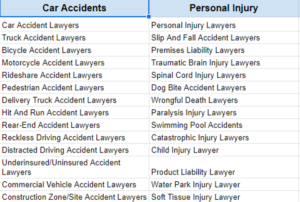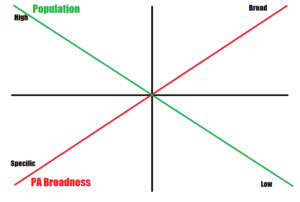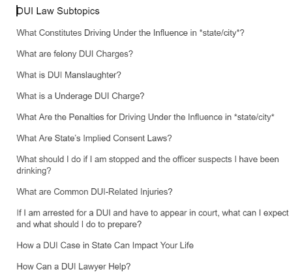When facing the demanding task of producing content at an aggressive pace—in some cases adding as many as 15-20 pages and blogs to your website a month—there are two elements you may begin to consider:
- The ‘end goal’ for your page strategy: After all, there must be a finite number of pages that can be added to your website for short-tail keywords. The blogging strategy, or long-tail keywords, is arguably indefinite. This is why a strategy needs to come into play that can clarify the end goal.
- Creating content efficiently without starting from scratch: When you begin to write your content, you’ll want to find a way to do so effortlessly without feeling like you have to start the research process over every time a new piece is created.
Implementing an unambiguous and straightforward plan for the content that will live on your website is crucial. We’ve broken down a few methods with which to carry out your vision.
Three Approaches to Executing Content
There are three techniques we would suggest employing in order to have a clear blueprint for the execution of content.
Content Mapping
 This one may seem straightforward, but content planning in the form of “mapping” is a technique rarely applied. The sitemap on your website (commonly, example.com/sitemap.xml or /sitemap.html) is already, in many ways, a great starting point for “mapping” out all of the potential pages your website will ever require or need to capture all short-tail or vanity keywords. To reiterate, there is technically a finite amount of short-tailed or vanity keywords to create because Google’s big data way of learning should, and typically does, associate words to the point of interchangeability. For example, you may be reading and know the precise details that differentiate “lawyer” from “attorney,” but the typical consumer will just use them as a preference, almost more as a colloquialism.
This one may seem straightforward, but content planning in the form of “mapping” is a technique rarely applied. The sitemap on your website (commonly, example.com/sitemap.xml or /sitemap.html) is already, in many ways, a great starting point for “mapping” out all of the potential pages your website will ever require or need to capture all short-tail or vanity keywords. To reiterate, there is technically a finite amount of short-tailed or vanity keywords to create because Google’s big data way of learning should, and typically does, associate words to the point of interchangeability. For example, you may be reading and know the precise details that differentiate “lawyer” from “attorney,” but the typical consumer will just use them as a preference, almost more as a colloquialism.
The same commonly applies to “car” and “auto.” Many other forms of the search will also, to an extent, be considered variations of the same core keywords, including singular vs. plural, and inflections of the keyword (i.e., “Boston car accident lawyer” vs. car accident lawyer Boston).
This (fortunately) allows us to have a predictably finite number of pages on our website long-term to capture keywords. This is also why we don’t have a dedicated page for “car accident lawyer” in addition to “car accident lawyers”. This would be considered “keyword cannibalization” and would do much more harm than good for your website.

When executing content mapping, we think about every geo we want to be present in geographically and couple that with every granular practice area for which we would accept cases. For instance, if we’re in a small metro area with eight cities with a population of 20,000 more surrounding us and we will accept about 15 specific types of cases, we now have 120 potential pages to create.
After excusing my use of MS Paint, you can apply the simple matrix seen above as a way of potentially filtering some pages on your content map as “not a good use of time.” This means the lower the population of the geo you’re building out, the less granular you can get with your PA, and vice versa.
It’s also important to consider that a “rear-end collision lawyer” page may work in LA, but it may not work well in West Hollywood.
Compiling Reliable Sources
When finding sources for content, it’s typically a proactive thought to compile the links that have proven to have consistent, reliable information. Once you start referencing other websites with reliability on a regular basis, you’ll want to start keeping a running list (or simply, a folder of bookmarks) with your strongest “go-tos”. It may seem like you have to start at square one with each new topic and article, but you’ll be surprised how thorough your resources will be at covering many other topics you’ll have in the future.
Sub-Topic Approach
 There’s a reason the “listicle” craze has been so popular: they are easy to write. When you go into a topic, the more sub-topics you have available, the easier it is to formulate ideas and execute each section. Even with this article, I know there’s an intro, three sub-topics, and an outro, so we’re almost across the finish line already! Many sub-topics can be viewed as your FAQs as well, but they also, in a way, set the messaging and tone you’re looking to convey for your firm.
There’s a reason the “listicle” craze has been so popular: they are easy to write. When you go into a topic, the more sub-topics you have available, the easier it is to formulate ideas and execute each section. Even with this article, I know there’s an intro, three sub-topics, and an outro, so we’re almost across the finish line already! Many sub-topics can be viewed as your FAQs as well, but they also, in a way, set the messaging and tone you’re looking to convey for your firm.
For example, if you’re a criminal defense lawyer, you may have different routes you want to take with your content in the way of conversion and storytelling. Some criminal lawyers may want to use a degree of aggression and urgency in their copy and have sub-topics consistent on their practice area pages, such as:
- Why a public defender may result in jail time
- Why you can’t afford not to hire private counsel for a criminal matter
- The timeline in which you must retain a lawyer to review your case and organize a defense.
Another criminal lawyer may prefer to take a route such as:
- What your potential defense are
- The penalties/charges associated with your crime
- What you can do on your own to mitigate the consequences of your charges (prior to, of course, hiring private counsel)
Either approach may be more exemplary of the way you do things, but when they are solidified into sub-topics for your pages, you can easily execute large segments of the page with predictable content.
Contact the Content Marketing Specialists at Market My Market Today
Understanding and implementing a proper approach to your content is of foundational importance. At Market My Market, our content marketing experts will provide you with reliable, high-quality content plans prior to writing our top-notch blogs and pages. Our team of writers utilizes an already-existing content mapping and subtopic approach based on years of high-quality execution.
Content is our forte, and our passion for helping companies succeed is what makes us stand out from the crowd. Learn how we can improve your site’s ranking and position your firm as an industry leader. Contact us to request a free consultation by completing our contact form or calling us at (866) 834-3079.

The ongoing digital revolution is transforming the way that all businesses interact with clients and customers. Consumers rely heavily on digital channels for researching products and services and expect to make buying choices with the swipe of a finger. For organizations that want to remain competitive, having a defined digital marketing strategy and execution plan is essential for successful outcomes. With a demonstrated history of creating and implementing strategic digital marketing initiatives that drive growth, I am committed to delivering real, measurable results for my clients.


